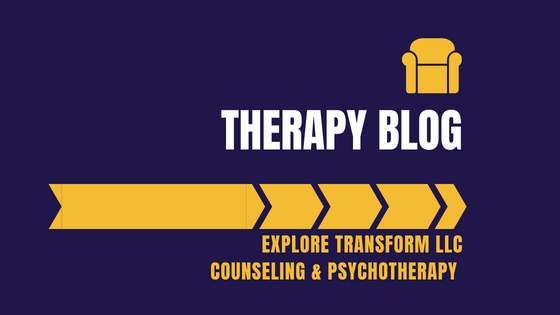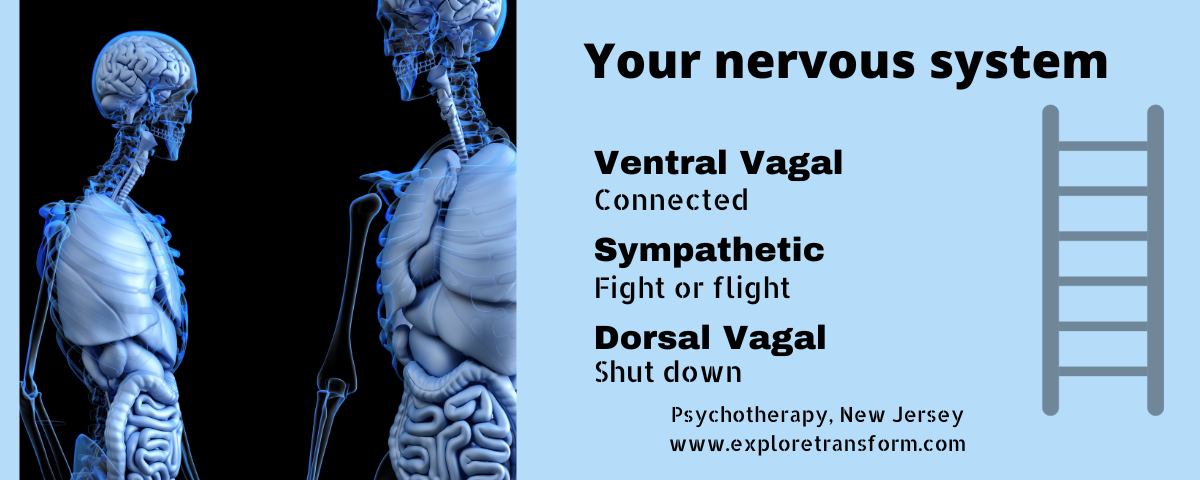|
Blog roundup from Explore Transform counseling and psychotherapy. Specializing in trauma and EMDR. Book a free callback today. Explore Transform LLC Counseling and Psychotherapy in Bergen County, New Jersey www.exploretransform.com +1 (201) 779-6917 Depression is greatly associated with stress and trauma. When our nervous system is overwhelmed, so there is not even the hope of fighting or fleeing, we collapse. According to the latest research, 14.8 million U.S. adults had at least one major depressive episode with severe impairment in the past year (Anxiety and Depression Association of America).
I am a firm believer in empowering people with knowledge, so I want to share with you a particular type of EMDR that works particularly well with depression, and that is called DeprEnd EMDR. When we first talk to you, we will create an event map of all your depressive episodes, and we will cover your whole life, not just the current or most recent episode. We are looking for triggers for the depression but this can be hard as depression often lingers in the background, like an impending storm. We then need to see how you deal with everyday stressors. If you are having a particularly hard time, we might spend a little longer in the initial phase of this protocol, helping you to develop and use resources to better able these stressors. We also need to assess whether you can establish and use a safe place. This is a place or a memory that you can use to make you feel safe and calm, and it can be as simple as the image of a waterfall, lake, or beach. As we work within this phase, we will use slow eye movements to help reinforce the positive associations with these resources. We then move into the main part of DeprEnd EMDR, which is to choose episode triggers to reprocess. Reprocess means using rapid eye movements, pulsers, or toners, to desensitize these episodes and install more positive beliefs and associations. So we could reprocess stressful life events that took place one or two months before the depressive episodes. Some therapists use the Beck Depression Inventory (BDI) to measure improvement but other therapists find these measures to be restrictive, and they prefer to work collaboratively with the client to agree on an assessment of how the client is doing in response to the work. A focus of EMDR includes an identification of the negative belief/cognition related to that distressing memory. With DeprEnd EMDR, we also seek to identify a negative belief/cognition about the depressive episodes. For example, a prevailing belief might be “I am worthless”. In this case, we would ask you what in your life proves you are worthless, find a present trigger for that belief, identify the body affect, and float back on that body affect to find an earlier memory that represents this belief. However, EMDR does not just focus on the beliefs associated with depression. We are aware that the body holds onto a great deal of stress and trauma, and so we will work with you to identify (and reprocess, using rapid eye movements) depressive body states. The final part of the DeprEnd EMDR protocol is to rehearse future triggers for depressive episodes. We will ask you to identify the worst part of the anticipated future trigger (for example, seeing the sadness in your partner’s eyes), and we will help you to identify the quality you need to anticipate that (for example, courage or compassion). We will identify an image that represents that quality (for example, the image of you hugging yourself), we will get you to identify where you feel that in your body, and add rapid eye movements to that. Even though depression might be an inevitable part of our everyday life, the suffering can be reduced with a little bit of support and professional guidance. Take care of yourself. ~~~ I wonder if you have read anything that creates more questions in you. If you would like to explore these questions, I am here. You can reach out by calling, texting, or emailing me. Or you can use the contact form on the About page of this website. ~~~ Chris Warren-Dickins LLB MA LPC Explore Transform LLC Counseling and Psychotherapy in Bergen County, New Jersey www.exploretransform.com +1 (201) 779-6917 #trauma #depression #anxiety #emdr #therapist #psychotherapy #counseling #BergenCounty #NewJersey Here is a summer collection of our recent blog posts.
We hope you find these useful. Book online today for a free callback. Alternatively, you can email us at [email protected] or call us on +1 (201) 779-6917. Chris Warren-Dickins LLB MA LPC Explore Transform LLC Counseling and Psychotherapy in Bergen County, New Jersey www.exploretransform.com +1 (201) 779-6917  This is a fast-paced world that feels like it is spinning faster by the day: You jump each time there is a notification on your phone, your head spins from the incessant interruptions from your kids, you are constantly asked to work harder and quicker, and there are constantly new challenges from the wider environment (deteriorating air quality, intensifying storms, and increasing food prices, just to name a few). Now more than ever, there is a need to carve out space for a slower existence. Therapy can offer you that space, and it can take many different forms: Your therapist might invite you to slow down so you notice your breath, they might encourage you to slow down and scan your body, they might help you to slowly learn how to mindfully notice your emotions without having to respond to them, and they can help you to slow down your thought process so you can identify any short-circuited thought patterns. Years ago, when I trained as a psychotherapist I was also working as an attorney in London (UK). So, I know something about a frantic pace. But I also know how much of a toll it took on my physical and emotional well-being. That was when some observant person gave me the book In Praise of Slow, by Carl Honore. You’ll like this bit: “Our impatience is so implacable that, as actress-author Carrie Fisher quipped, even “instant gratification takes too long.” True, right? We are impatient, yes, but I think it is understandable when it comes to therapy. After all, we seek out therapy when we are troubled, in distress, in despair even, so why should we slow down and prolong that misery? The truth is, quick-fix solutions rarely, if ever, work. That is true of most things, whether it is a broken leg, mind, or spirit. Forming a relationship with your therapist takes time, and so it should do. Trust is not a given, and it needs to develop slowly. As a clinician, I need to take a bit of time to assess how easily you can pendulate between the past (for example, the story of your trauma) and the present. If I rush this process, I run the risk of overwhelming your nervous system and leaving you stuck in a trauma response. Important work that sometimes feels like slow work. Telling yourself that you are safe is insufficient. Instead, your body needs to feel safe and calm, and as Bessel van der Kolk pointed out by naming his book this way, The Body Keeps the Score. Often we can only heal when we slowly start to feel this in our body, when our nervous system comes out of shut-down, freeze, fight, or flight, and feels safe and calm and connected to yourself and the world around you. When I use EMDR with my clients, one of the final stages of the EMDR protocol is to do a body scan, where we check to see how the body feels when we bring up the distressing memory. Directionless rushing How can we rush the healing process when we don’t know where we are going? We need to feel better, but that is hard to identify, especially if we have grown up experiencing trauma. We can assume that our trauma responses are our natural state, and it can come as quite a surprise when we realize that we are not restless people, blank-minded, or emotionless, but we have been stuck in these trauma responses for so long. So we need to go slowly to reacquaint ourselves with who we are. Sort of like putting together the pieces of a jigsaw puzzle when we haven’t a clear picture of the end result. Again, this might take some time. In this fast-paced world, a world with so much trauma, what better way to heal, to show yourself that you are safe and of value, than to try a bit of slow healing. Take care of yourself. ~~~ I wonder if you have read anything that creates more questions in you. If you would like to explore these questions, I am here. You can reach out by calling, texting, or emailing me. Or you can use the contact form on the About page of this website. ~~~ Chris Warren-Dickins LLB MA LPC Explore Transform LLC Counseling and Psychotherapy in Bergen County, New Jersey www.exploretransform.com +1 (201) 779-6917 #trauma #psychotherapy #NewJersey Psychotherapist Chris Warren-Dickins welcomes you to Explore Transform counseling and psychotherapy, based in Ridgewood, New Jersey.
Book online today for a free callback. Alternatively, you can email us at [email protected] or call us on +1 (201) 779-6917. Many EMDR therapists use polyvagal theory to help someone understand that their body and mind are responding in a certain way because it is biologically built to do this. Your nervous system is responding to cues of danger or safety, and so symptoms of anxiety, depression, and trauma responses, are easier to understand when we view our nervous system as a ladder (as shown in the diagram below).
At the bottom of the nervous system ladder, in response to cues of danger, our nervous system can shut down. Here we can feel numb, blank-minded, even depressed. Think of how we might be caught by the saber-tooth tiger; our nervous system cleverly shuts us down so we do not feel the pain of the bite of the tiger. This is the work of the part of the parasympathetic nervous system that is known as the dorsal vagal response. In the middle of the nervous system ladder, in response to cues of danger that we have a hope of escaping, our nervous system will respond by increasing our heart rate so we can fight or flee the danger. Here we can find outbursts of anger and anxiety, and this is the work of the sympathetic nervous system. Finally, at the top of the nervous system ladder, we find the most evolved response, in response to cues of safety, when we can connect with ourselves and others. Thanks to our parasympathetic nervous system, this is the ventral vagal response. Together, we will help you to notice and name the different states, and you can use this awareness to flex in and out of the various states as appropriate. I hope you found this useful. Please get in contact if you need to discuss any of this. Book online today for a free callback. Alternatively, you can email us at [email protected] or call us on +1 (201) 779-6917. Chris Warren-Dickins LLB MA LPC Explore Transform LLC Counseling and Psychotherapy in Bergen County, New Jersey www.exploretransform.com +1 (201) 779-6917 |
Due to the COVID-19 health crisis, we are only offering sessions online.
Our address is 143 E Ridgewood Ave, #1484, Ridgewood, NJ 07450
Telephone: +1-201-779-6917
Lead clinician: Chris Warren-Dickins LLB MA LPC
EXPLORE TRANSFORM LLC
Our address is 143 E Ridgewood Ave, #1484, Ridgewood, NJ 07450
Telephone: +1-201-779-6917
Lead clinician: Chris Warren-Dickins LLB MA LPC
EXPLORE TRANSFORM LLC
© COPYRIGHT 2024 CHRIS WARREN-DICKINS. ALL RIGHTS RESERVED. NJ LICENCE # 37PC00618700















 RSS Feed
RSS Feed
